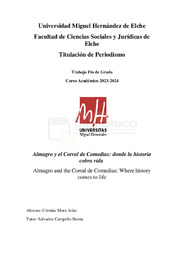Please use this identifier to cite or link to this item:
https://hdl.handle.net/11000/32711Full metadata record
| DC Field | Value | Language |
|---|---|---|
| dc.contributor.advisor | Campello Iborra, Salvador | - |
| dc.contributor.author | Mora Arias, Cristina | - |
| dc.contributor.other | Departamentos de la UMH::Ciencias Sociales y Humanas | es_ES |
| dc.date.accessioned | 2024-07-26T08:20:57Z | - |
| dc.date.available | 2024-07-26T08:20:57Z | - |
| dc.date.created | 2024-06 | - |
| dc.identifier.uri | https://hdl.handle.net/11000/32711 | - |
| dc.description.abstract | Almagro, un legado histórico y cultural en el corazón de Castilla-La Mancha, declarada Conjunto Histórico-Artístico en 1972. Fue fundada hace ochocientos años por la Orden de Calatrava, quienes dejaron una importante riqueza arquitectónica y cultural en la ciudad. Sin embargo, su máximo esplendor llegó en los siglos XVI, XVII y XVIII, convirtiéndose en un importante centro económico y cultural gracias al comercio de la lana y la agricultura. Durante esta época se construyeron la Plaza Mayor, la Iglesia de San Agustín, y el Corral de Comedias. El Corral de Comedias es un testigo vivo de la tradición teatral del Siglo de Oro, construido en 1628 por Leonardo de Oviedo. El único Corral de Comedias de Europa que conserva su estructura original y sigue en activo como teatro. Consta de una arquitectura tradicional manchega y se considera una obra maestra, desde su patio de butacas hasta sus balcones. En este espacio se vive la tradición teatral, donde solo se puede disfrutar de obras nacidas en el Siglo de Oro, sumergiendo tanto a actores como a público en una atmósfera histórica. El Corral de Comedias ha sido escenario de artistas tan significativos como Lope de Vega o Cervantes, cuyas obras han dejado huella en nuestro patrimonio cultural. En Almagro, la historia y el arte cobran vida. | es_ES |
| dc.description.abstract | Almagro, a historical and cultural legacy in the heart of Castilla-La Mancha, declared a Historic-Artistic Site in 1972. It was founded eight hundred years ago by the Orderof Calatrava, who left an important architectural and cultural wealth in the city. However, its maximum splendor came in the sixteenth, seventeenth and eighteenth centuries, becoming an important economic and cultural center thanks to the wool trade and agriculture. During this period, the Plaza Mayor, the Church of San Agustín, and the Corral de Comedias were built. The Corral de Comedias is a living witness of the theatrical tradition of the Golden Age, built in 1628 by Leonardo de Oviedo. It is the only Corral de Comedias in Europe that preserves its original structure and is still active as a theater. It has a traditional Manchegan architecture and is considered a masterpiece, from its stalls to its balconies. In this space the theatrical tradition is lived, where you can only enjoy plays born in the Golden Age, immersing both actors and audience in a historical atmosphere. The Corral de Comedias has been the stage for artists as significant as Lope de Vega or Cervantes, whoseworks have left their mark on our cultural heritage. | es_ES |
| dc.format | application/pdf | es_ES |
| dc.format.extent | 25 | es_ES |
| dc.language.iso | spa | es_ES |
| dc.publisher | Universidad Miguel Hernández de Elche | es_ES |
| dc.rights | info:eu-repo/semantics/openAccess | es_ES |
| dc.rights | Attribution-NonCommercial-NoDerivatives 4.0 Internacional | * |
| dc.rights.uri | http://creativecommons.org/licenses/by-nc-nd/4.0/ | * |
| dc.subject | Almagro | es_ES |
| dc.subject | Orden de Calatrava | es_ES |
| dc.subject | Corral | es_ES |
| dc.subject | Siglo de Oro | es_ES |
| dc.subject | Arquitectura | es_ES |
| dc.subject | Order of Calatrava | es_ES |
| dc.subject | Golden Age | es_ES |
| dc.subject | Architecture | es_ES |
| dc.subject.other | CDU::0 - Generalidades.::070 - Periódicos. Prensa. Periodismo. Ciencias de la información | es_ES |
| dc.title | Almagro y el Corral de Comedias: donde la historia cobra vida | es_ES |
| dc.title.alternative | Almagro and the Corral de Comedias: Where history comes to life | es_ES |
| dc.type | info:eu-repo/semantics/bachelorThesis | es_ES |

View/Open:
PER_TFG_MORA_ARIAS_CRISTINA.pdf
692,67 kB
Adobe PDF
Share:
.png)
